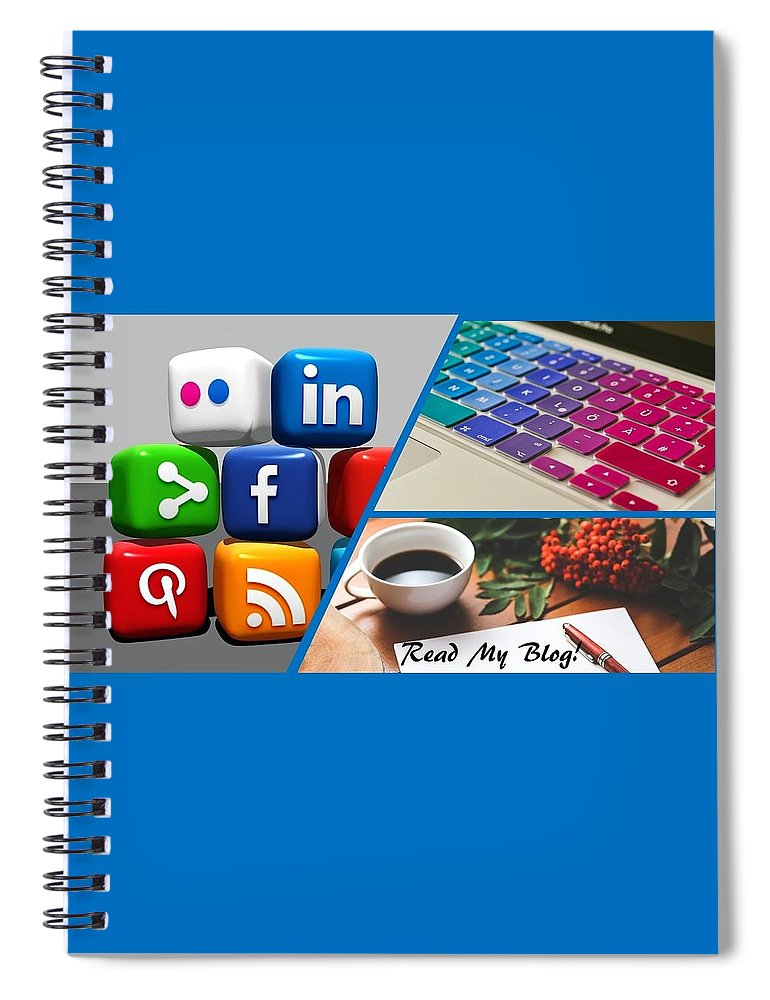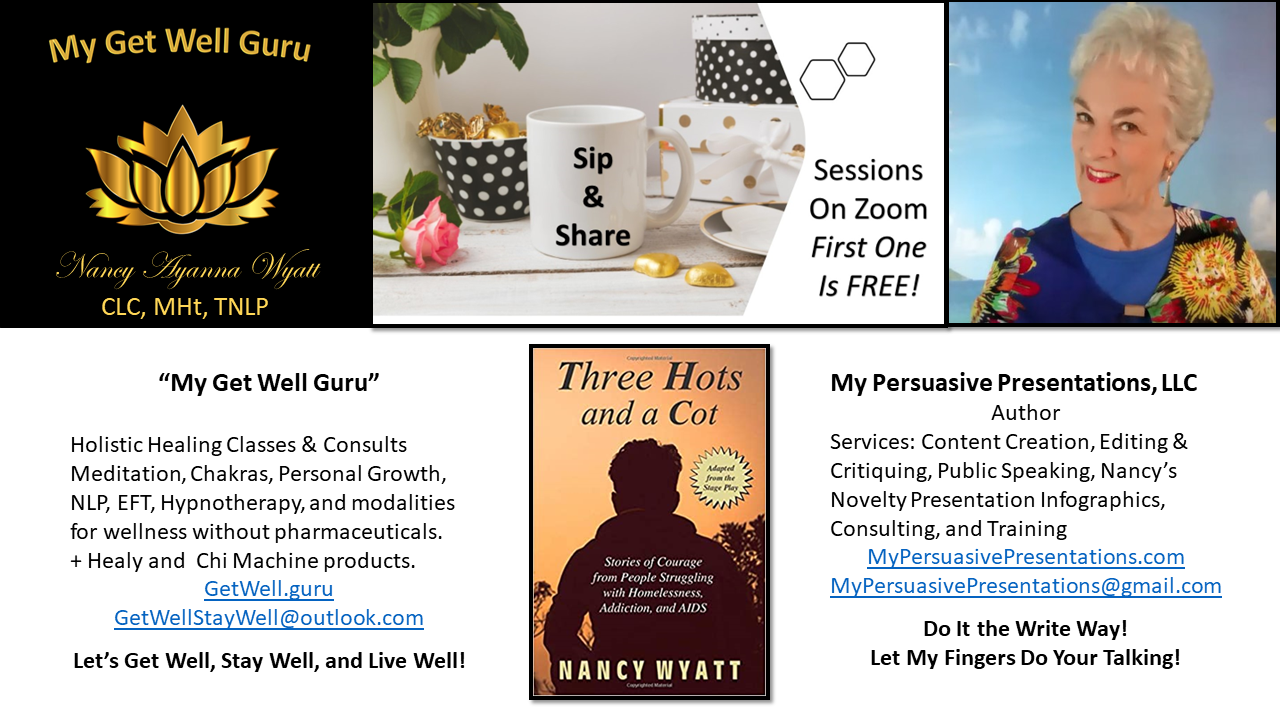
Blogs, Bios, and Branding Can Be Wed With Great Results!

Why Blog?
Do you need or want to get autobiographical information “out there” for the public to devour? Are you trying to create a large following before you publish your book or launch a product? Perhaps, you want to attract customers to your existing business, or supporters for the cause about which you are most passionate. Or, maybe it’s personal.
Maybe you simply want to find compatible friends with shared interests, leave a legacy for future generations in your family, or communicate with fellow readers/writers.
You also can use blogs to survey people about ideas, causes, new products or services, and to take polls or request suggestions.
Way back in 2015, I offered to teach Seniors (people of a certain age) how to use a computer to create blogs, some of which might simply be for friends and family. That offer is still available, so you or your loved one can contact me if you’re interested. Meanwhile ~

Regardless of your motivation, your success may be dependent on understanding the expectations of your audience and how well you design what you write. People get “turned off” by “salesy” content, so I’ll mention a way to avoid that.
For newcomers, we’ll see that blogging is easy, albeit time-consuming. You can minimize time spent on posting also. I’ll provide links to help you with that.

Combining Blogs with Bio Info and Branding

Most blogs are not simply autobiographical, but they can be for someone who is famous enough to have people actually care about their adventures and misadventures, or what makeup tips and tricks they use.
For the rest of us, below are suggestions about things to include in a blog and how to use snippets about yourself on social media, for speaking engagements, and other branding opportunities.
When you do use biographical information, you might want to customize segments of your history or credentials for shorter posts, for web content in the “About” tab, and for you and others to use as introductions when you have a speaking engagement. Below, we’ll talk about how.
First, WHAT Is A Blog?

To blog is to add new material to or regularly update a blog. For example, “it’s been about a week since I last blogged.”

Read My Blog – Spiral Notebook, Mugs, Tote Bags, and More
The earliest concept of blog content was ‘a personal, informal way of speaking, in writing, as if you were in conversation with a person in front of you.’
That written content is posted on one’s website or on various social media platforms. The posts show the dates, and the most recent one is visible to the public (or the selected audience). The computer system typically will archive older blog posts in a saved file folder for all your posts.
Over time, blogs have evolved and may be written by multiple contributors. They might be about issue content – rather than autobiographical – and might include visual images in addition to written content. Note: the counterpart is Vlogs. Vlogs are similar but are created in video formats.
Wikipedia provides a more formal definition, as follows.
Usually, people may comment on what you write. In the settings on the platform you use, you can allow those comments to show or choose not to.
You can write short blogs, long blogs, or share other people’s blogs.
Styles

The blog author may choose what to include in blogs from among several options. However, IN ALL CASES, beware of copyright violations (for both text and pictures).
If you are not the author/originator, make sure that – either you don’t need permission or that you have written (or otherwise verifiable confirmation) that you do have permission to use the materials of other sources.
Here are some ideas for content.
- Text (words) only
- Words plus pictures
- Pictures only (such as a photo album, or a portfolio of your paintings, fashion designs, etc. You might also post those images on Instagram or Pinterest – both of which can be good for leading people to your website.)
- Videos
- Any combination of media
- Whole articles on differing subjects
- Chapters of your book – like a series, but in blog format. Channillo allows people to post partial work, such as individual chapters, one at a time – over time – on their website. Be careful about what you choose to do in that kind of situation or in blogging, as the work will be considered to have been “published,” and you/it may become ineligible for contests and other writing opportunities that accept only unpublished work.
- Short statements (like on Twitter)
Making Content Effective
The BIG Questions!

Above all, you should be able to give a good answer to WHY anyone would want to read your blog – or WHY they would choose to read about the chosen subject matter in opinions from YOU. When you attempt to answer that question, you will find it helps focus the mind and will help you “get real.”
You may wind up changing the topic and/or your approach to the topic when you do this in conjunction with deciding WHO YOUR TARGET AUDIENCE IS.
- Some blogs are intended for a specific small audience (like for astrophysicists), while others are created “for the world” in the hope they “go viral.”
- Know what you’re doing.
- If you don’t know, DECIDE. Decide on a path forward, knowing you can do additional or different blogs later.
- However, keep in mind that the impression you make the first time around will affect your credibility in future endeavors.
Visuals

Visuals are likely to attract attention far more easily than written words alone. Research has shown repeatedly that pictures of food, babies, and animals are the most popular. Ensure that whatever images you use are directly relevant to the content you’re publishing.
Hyperlinks
![]()
Insert hyperlinks to your website and to others (for Search Engine Optimization (SEO) so that your post is not the millionth in a queue of 1.5M posts).
- For example, if you are giving a definition or mentioning a sample, you could insert a hyperlink to that source.
- If you are referring to something you wrote before, or that you’re selling on your website, you can put a hyperlink to that article or POS page.
Avoiding Sales Pitches

Instead of including a sales pitch, you could include anecdotes about someone who faced a problem that you were able to solve. Better yet, tell the story about how someone (preferably an authoritative source) recommended you as the person who could provide solutions. Be careful not to sound egotistical or self-aggrandizing.
Alternatively, talk about an issue from a global perspective and then draw it down into a more national, regional, and local perspective, after which you may offer suggestions for resolution.
One recommendation for businesses is to post 1/3 educational content, 1/3 entertaining content, and 1/3 directly-related-to-your-business content.
Call to Action

However, if you are creating blogs for your business, don’t forget to include a Call to Action (mention what you want your reader to do after they have read your blog) PLUS your contact information at the end of your blog.
- Click a link to place an order.
- Share a blog post or graphic with their followers.
- Call a 1-800 number to place an order.
- Follow you on a social media platform.
- Call a number to hear a recorded message.
- Fill in a form to subscribe to a newsletter or get a free gift.
- Click a link for more information.
- Fill in a form to enter a sweepstakes.
How Long Should Your Blogs Be?

Be concise. Write blogs that are not too long. Of course, I violate that guideline all the time. What I have learned is that there are two different criteria for how long a post should be. If you want people actually to read what you wrote, shorter is better. If you want higher SEO rankings, Google likes it longer. Let’s get more precise about the long ones.
Ideal Blog Post Length for SEO 2021 “For SEO, the ideal blog post length should be 2,100-2,400 words, according to HubSpot data. We averaged the length of our 50 most-read blog posts in 2019, which yielded an average word count of 2,330. Individual blog post lengths ranged from 333 to 5,581 words, with a median length of 2,164 words.
Still, you don’t have to write long posts every time. Sixteen of HubSpot’s top fifty posts (or about one-third) were under 1,500 words. They may have been very interesting, and/or they may have used techniques to increase visibility (SEO) on the Internet.
Regardless of Length, Here Are Common Concepts for Success

- Make sure your points are focused – preferably toward the interests of the niche you want as your target audience.
- Some people talk about whatever is going on in their lives in story-telling mode. However, other successful bloggers emphasize one topic or area of interest, such as Climate Change, or space travel.
- If you chose to do the former, you probably need to use a lot of humor or to describe painful events that you (or your protagonist) are struggling to overcome. It’s all about the laughs or the drama – or both.
- If you choose to do the latter, please ensure your data and information are well-researched a) so you don’t disseminate misinformation, and b) so you don’t have the unwelcome experience of being challenged by people disproving what you say in the replies.
- Bring a unique perspective. Say “NO” to plagiarism and “put your own spin on it.” For example, unless you had a wildly unusual and/or amusing experience, don’t write about your summer picnic. Instead, consider writing about “Picnic Foods In Countries Around the World.”
- Establish yourself as an authority in your field.
- You can do this by subtle sentences in which you mention having been the Keynote Speaker at an event or about the time when you led x number of troops in battle. Other ways to do it include:
- Linking to white papers, your web pages on the subject, or presentations you have made. (Doing so may help your SEO, too.)
- Including the letters – indicating advanced levels of academic achievement or certifications you have earned – behind your name in a pinned post.
- You can insert these things in the customary “About” section on your website or in a pinned post at the top of social media feeds.
- Additionally, if there is room and it is appropriate, list your credentials or honors and awards. Perhaps, your community or job experience is pertinent.
- You can do this by subtle sentences in which you mention having been the Keynote Speaker at an event or about the time when you led x number of troops in battle. Other ways to do it include:
- Use hashtags to increase viewership. Click Here to learn what Media Maven, Liz Evangelatos Barney ツ @AskForLiz shared when she was a Guest Contributor to my blog.
Save Time In Posting to Social Media

Several companies offer apps, giving you the ability to post to multiple social media outlets (like Facebook, Instagram, LinkedIn, and Pinterest) simultaneously. Some have free versions, as well as multiple levels of paid packaging. Your choice depends on how frequently you plan to post and to how many sites, as well as how many people will do the posting. Click Here to find a list and comparison among favorites.
Use Introductory Autobiographical Information In Multiple Ways

I teach a Zoom class about how to create persuasive elevator speeches. In that class, I also teach you how to use the same material in expanded forms for different occasions.
You might have only 30 seconds to talk in an elevator ride. However, you can use that material and expand it for when you are seated next to a stranger at a social event or a conference, when you meet someone during a commute, or you are talking with the person seated next to you while waiting for a concert to start.
If your material is really good, you also can use it as an introduction in the “About” section on social media or on a web page. In addition, you can give it to a Master of Ceremonies to introduce you as a speaker on a panel, for instance.
To do that we craft a long version of the kind that might be used for the About page on your website, and then we pare it down to the barest essentials for that 30 – 60 seconds on an actual elevator ride. Learn More Here.
Branding

Branding is a topic about which volumes are written. For our purposes, I’ll just mention that you are creating an indelible impression when you blog, and your presence on social media ensures that the images and content you share may “live forever” through constantly recycled places on the Internet.
“The first impression is the last impression” normally is true. There are infrequent occasions when a person can overcome having given a negative impression, but that doesn’t happen often, and a negative sense of you may underlie all future encounters. Further, it is hard to overcome having given someone a bad view of you when you cannot interact face-to-face and all communication is by reading and writing.
Therefore, be sure what you write reflects the values and ideas that represent you well, as if your Mother, your Spouse, your Child, your Customer, your Religious or Spiritual leader, and your Boss were reading it. Does it pass muster?
If yes, then you can think about what logos, colors, font type, and messages fit your “brand” – whether that is a formal, business brand, or simply a reflection of your personality and interests.
I already gave you this next link for learning more about using hashtags. If you did not view it then, feel free to do so now for more info about branding. Click Here to learn what Media Maven, Liz Evangelatos Barney ツ @AskForLiz shared when she was a Guest Contributor to my blog.
I hope this has been useful to you.

If you are interested in taking a more in-depth class with me via Zoom, just email me at MyPersuasivePresentations@gmail.com and put “Inquiry About (whatever your area of interest is) Classes” in the subject line.
Do It the Write Way! Let My Fingers Do Your Talking!
